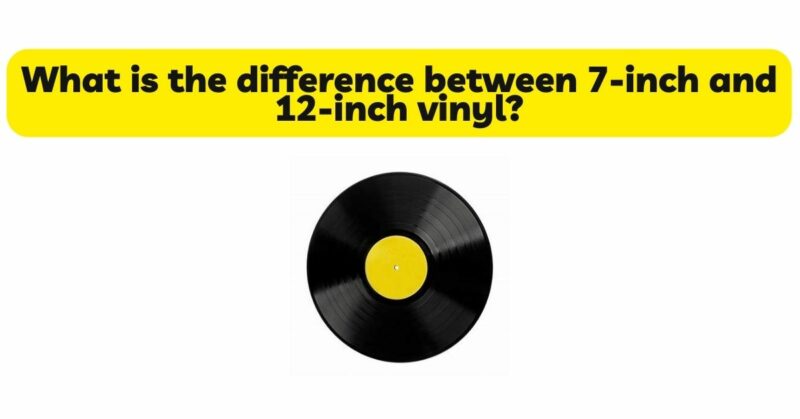Vinyl records have experienced a resurgence in popularity, captivating music enthusiasts with their warm, analog sound and tangible experience. Among the various vinyl sizes available, two prominent formats stand out: the 7-inch and 12-inch vinyl records. In this article, we will delve into the differences between these two sizes, exploring their impact on sound quality, playtime, artwork presentation, and overall listening experience.
- Size and Physical Characteristics: The most apparent distinction between 7-inch and 12-inch vinyl records lies in their size. A 7-inch record has a smaller diameter, typically around 7 inches (17.5 cm), while a 12-inch record measures around 12 inches (30 cm) in diameter. This size difference influences several aspects of the vinyl record, including playtime, sound quality, and artwork presentation.
- Playtime and Track Capacity: One of the primary differences between 7-inch and 12-inch vinyl records is the amount of playtime they offer. Due to its smaller size, a 7-inch record has limited space for grooves, resulting in a shorter playtime per side. Typically, a 7-inch record can accommodate one song per side, resulting in a total playtime of around two to four minutes per side. In contrast, a 12-inch record provides a larger playing surface, allowing for longer grooves and extended playtime. This enables artists to include multiple tracks, resulting in an average playtime of 18 to 22 minutes per side.
- Sound Quality and Groove Space: The size of a vinyl record directly impacts the available space for grooves, which, in turn, affects the sound quality. Due to their larger size, 12-inch records have wider grooves compared to 7-inch records. This wider groove space allows for more detailed audio information to be captured during the pressing process, resulting in potentially better sound fidelity and dynamic range. However, it is worth noting that the difference in sound quality may not be noticeable to the casual listener or those without high-quality audio equipment.
- Artwork and Packaging: Another significant difference between 7-inch and 12-inch vinyl records is the space available for artwork and packaging. The larger surface area of a 12-inch record provides artists with ample canvas space to showcase elaborate album covers, intricate artwork, and additional inserts such as lyric sheets, posters, or booklets. The expanded real estate allows for more detailed and visually captivating artwork, enhancing the overall album experience. In contrast, the smaller size of a 7-inch record limits the available space for artwork, often resulting in simpler designs and fewer additional inserts.
- DJ Usage and Performance: The size of a vinyl record can also impact its usage in the DJ community. DJs often prefer 12-inch records for their larger size, as it allows for more precise cueing, beat matching, and scratching. The increased diameter provides DJs with more control over the vinyl, facilitating smoother transitions between tracks and enhanced creativity during live performances. While 7-inch records are less common in DJ sets, they can still be used effectively, particularly for specific genres or in situations where portability is a priority.
- Collectibility and Rarity: Collectors often value vinyl records for their rarity and uniqueness. Both 7-inch and 12-inch records have their own appeal in terms of collectibility. 7-inch records, often released as singles or limited editions, can hold a special allure due to their compact size and relative scarcity. These records are frequently sought after by collectors and can command high prices. On the other hand, 12-inch records, especially those with unique variants, colored vinyl, or special packaging, are alsohighly coveted by collectors. The larger size of 12-inch records allows for more extensive and visually stunning editions, often released as limited or deluxe editions, further enhancing their collectibility.
Conclusion: The differences between 7-inch and 12-inch vinyl records encompass various aspects, including size, playtime, sound quality, artwork presentation, and usage. 7-inch records offer a compact format with shorter playtime per side, making them suitable for singles and promotional releases. 12-inch records provide an immersive listening experience with longer playtime and potentially enhanced sound quality due to wider grooves. The larger size of 12-inch records also allows for more elaborate artwork and additional inserts, enhancing the overall album presentation.While both sizes have their unique appeal and purpose, they cater to different preferences and usage scenarios. DJs often prefer 12-inch records for their performance capabilities, while collectors may appreciate the rarity and compactness of 7-inch records. Ultimately, the choice between 7-inch and 12-inch vinyl records depends on personal preference, listening habits, and the desired experience.Embrace the diverse world of vinyl records, explore different sizes, and let your musical journey be enhanced by the unique qualities each format offers. Whether you opt for the compact and collectible nature of 7-inch records or the immersive experience provided by 12-inch records, vinyl remains a timeless medium that continues to captivate music enthusiasts worldwide.

